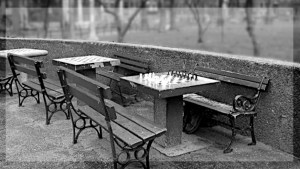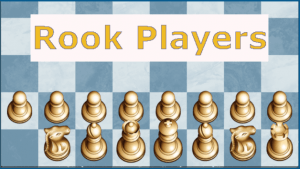
Pfc. Seidman
|
 Along with Reuben Fine and Samuel Reshevsky, these were considered the best This story, however, is about someone who perhaps didn't attain quite the same position or achieve the name recognition of most of the above, but who was, nonetheless, a remarkable chess talent and a feared opponent.  1940
In 1941, Seidman placed 7th-8th in the N.Y. championship (won by Fine). 1942 was a good year. Seidman came in 3rd in the US championship behind Howowitz and the winner, Kashadan. But more importantly, he won the Marshall Club championship with no loses (+10=2) firmly ahead of second-placed Anthony Santasiere who scored +9-2=1. 
  He graduated in 1942 and that July enlisted in the army, letting chess fall by the wayside for a couple of years. The next year, he married Phoebe Gilman, a Brooklyn College graduate and elementary school teacher.  Phoebe and Herb Seidman at the Marshall Club In 1944, Pfc. Seidman returned to chess and once again won the Marshall Club championship.  
 Seidman losing to Horowitz, second place winner at the 1944 Lightning Chess Championship. Seidman also won the Marshall Club championship in 1945, 1946 (with Milton Hanauer), 1955-6 (+11-4, ahead of Santasiere and Pilnik). Surprisingly in 1965, after a 2 year hiatus from chess, Seidman won the 50th Anniversary Marshall Chess Club championship with no losses (+36=19).  1945 Radio Match Seidman was invited to play on the U.S. team in the scheduled Radio Match against the U.S.S.R. In that match, each player was paired with one from the opposite team with whom he played two games, one a Black, one as White. Seidmam was paired with the well-known Viacheslav Ragozin. The American team only scored two wins in that ill-fated match and, while Seidman lost both his games to Ragozin, there's something worth noting. In his annotations to the first game in which Seidman had the Black pieces, he wrote after move 35, "Adjourned after thirteen hours of play" and after move 36, "I resume play, not exactly refreshed after two hours traveling, eight hours work and no sleep!"
Herb Seidman earned an M.B.A. and took a job with the American Cancer Society in 1948, attaining the position of vice-president for Epidemiology and Statistics. He retired from this job in 1989. Several of his writings on smoking-related cancer and breast cancer were published in scientific journals and often cited as expert data. The Seidmans had two sons, Richard and Peter. In 1991 he and Phoebe moved to Ballston Lake in the Capital District of upstate New York. Phoebe, along with her daughter-in-law, Ann (both were Brooklyn College graduates and both taught elementary school), played viola in both Brooklyn and Ballston Lake community orchestras.  Phoebe Seidman, born on October 13, 1924, passed away on August 21, 2008. Seidman played in a host of U.S. Opens. His best result seems to have been 8th place in 1946. He had better luck in the U.S. Championship, placing 3rd (behind Howowitz and Kashadan) in 1942, 3rd (behind Bisguier and Evans) in 1954, 4th (behind Evans, Reshevsky and Pavey) 1951, 5th in 1961-2, 7th 1959-60, 9th 1957-8 and 12th in 1960. In 1968 he scored near the bottom. In 1961 Seidman shared the N.Y. championship with Pal Benko and won the championship outright in 1971. Herbert Seidman passed away on August 30, 1995 at age 74. Here is a small selection of games: |






